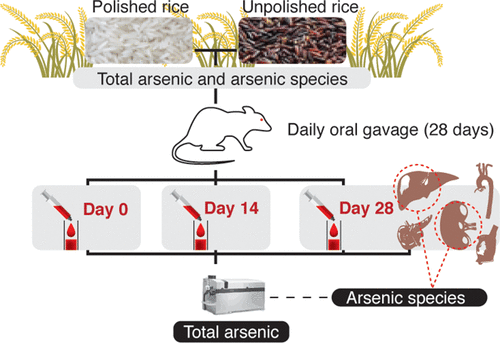当前位置:
X-MOL 学术
›
J. Agric. Food Chem.
›
论文详情
Our official English website, www.x-mol.net, welcomes your feedback! (Note: you will need to create a separate account there.)
Arsenic Speciation and Accumulation in Selected Organs after Oral Administration of Rice Extracts in Wistar Rats
Journal of Agricultural and Food Chemistry ( IF 6.1 ) Pub Date : 2018-03-10 00:00:00 , DOI: 10.1021/acs.jafc.7b05746 Kittima Lewchalermvong , Nuchanart Rangkadilok 1 , Sumontha Nookabkaew , Tawit Suriyo 1 , Jutamaad Satayavivad 1
Journal of Agricultural and Food Chemistry ( IF 6.1 ) Pub Date : 2018-03-10 00:00:00 , DOI: 10.1021/acs.jafc.7b05746 Kittima Lewchalermvong , Nuchanart Rangkadilok 1 , Sumontha Nookabkaew , Tawit Suriyo 1 , Jutamaad Satayavivad 1
Affiliation

|
Despite its nutritional values, rice also contains arsenic. There has been increasing concern about health implications associated with exposure to arsenic through rice consumption. The present study evaluated arsenic accumulation and its speciation in selected organs of Wistar rats after 28 day repeated oral administrations of polished or unpolished rice and their control arsenic compounds (sodium arsenite or dimethylarsinic acid; DMA). Only the treatment of sodium arsenite (2 μg/kg body weight), significantly increased total arsenic concentrations in blood when compared to the distilled water control group. In all groups, total arsenic concentrations were highest in kidney (1.54–1.90 mg/kg) followed by liver (0.85–1.52 mg/kg), and the predominant arsenic form in these organs was DMA. However, there was no significant difference in arsenic accumulation in the measured organs among the control and rice-treated groups. Therefore, the repeated 28 day administration of arsenic-contaminated rice did not cause significant arsenic accumulation in the animal organs.
中文翻译:

Wistar大鼠口服水稻提取物后砷在某些器官中的形成和积累。
尽管其营养价值,大米还含有砷。人们越来越担心与通过食用大米接触砷有关的健康问题。本研究评估了28天重复口服精制或未抛光的大米及其对照砷化合物(亚砷酸钠或二甲基亚砷酸; DMA)后Wistar大鼠选定器官中砷的积累及其形态。与蒸馏水对照组相比,仅亚砷酸钠(2μg/ kg体重)的治疗显着增加了血液中的总砷浓度。在所有组中,肾脏中的总砷浓度最高(1.54–1.90 mg / kg),其次是肝脏(0.85–1.52 mg / kg),这些器官中的主要砷形式是DMA。然而,在对照组和水稻处理组之间,被测器官中砷的积累没有显着差异。因此,重复28天施用受砷污染的大米不会引起动物器官中大量砷的积累。
更新日期:2018-03-10
中文翻译:

Wistar大鼠口服水稻提取物后砷在某些器官中的形成和积累。
尽管其营养价值,大米还含有砷。人们越来越担心与通过食用大米接触砷有关的健康问题。本研究评估了28天重复口服精制或未抛光的大米及其对照砷化合物(亚砷酸钠或二甲基亚砷酸; DMA)后Wistar大鼠选定器官中砷的积累及其形态。与蒸馏水对照组相比,仅亚砷酸钠(2μg/ kg体重)的治疗显着增加了血液中的总砷浓度。在所有组中,肾脏中的总砷浓度最高(1.54–1.90 mg / kg),其次是肝脏(0.85–1.52 mg / kg),这些器官中的主要砷形式是DMA。然而,在对照组和水稻处理组之间,被测器官中砷的积累没有显着差异。因此,重复28天施用受砷污染的大米不会引起动物器官中大量砷的积累。

























 京公网安备 11010802027423号
京公网安备 11010802027423号